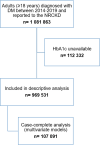The effect of comorbidities on glycemic control among Colombian adults with diabetes mellitus: a longitudinal approach with real-world data
- PMID: 34174843
- PMCID: PMC8235812
- DOI: 10.1186/s12902-021-00791-w
The effect of comorbidities on glycemic control among Colombian adults with diabetes mellitus: a longitudinal approach with real-world data
Abstract
Background: Achieving an optimal glycemic control has been described to reduce the incidence of diabetes mellitus (DM) related complications. The association between comorbidities and glycemic control remains unclear. Our aim is to evaluate the effect of comorbidities on glycemic control in people living with DM.
Methods: A retrospective longitudinal study on data from the National Registry of Chronic Kidney Disease from 2014 to 2019 in Colombia. The outcome was poor glycemic control (PGC = HbA1c ≥7.0%). The association between each comorbidity (hypertension (HTN), chronic kidney disease (CKD) or obesity) and PGC was evaluated through multivariate mixed effects logistic regression models. The measures of effect were odds ratios (OR) and their 95% confidence intervals (CI). We also evaluated the main associations stratified by gender, insurance, and early onset diabetes as well as statistical interaction between each comorbidity and ethnicity.
Results: From 969,531 people at baseline, 85% had at least one comorbidity; they were older and mostly female. In people living with DM and CKD, the odds of having a PGC were 78% (OR: 1.78, CI 95%: 1.55-2.05) higher than those without CKD. Same pattern was observed in obese for whom the odds were 52% (OR: 1.52, CI 95%: 1.31-1.75) higher than in non-obese. Non-significant association was found between HTN and PGC. We found statistical interaction between comorbidities and ethnicity (afro descendant) as well as effect modification by health insurance and early onset DM.
Conclusions: Prevalence of comorbidities was high in adults living with DM. Patients with concomitant CKD or obesity had significantly higher odds of having a PGC.
Keywords: Chronic kidney Disease; Comorbidity; Diabetes mellitus; Glycated hemoglobin A1c; Hypertension; Obesity.
Conflict of interest statement
The authors declare that they have no competing interests.
Figures



Similar articles
-
Is Uncontrolled Diabetes Mellitus Associated with Incidence of Complications After Posterior Instrumented Lumbar Fusion? A National Claims Database Analysis.Clin Orthop Relat Res. 2021 Dec 1;479(12):2726-2733. doi: 10.1097/CORR.0000000000001823. Clin Orthop Relat Res. 2021. PMID: 34014844 Free PMC article.
-
Paradox of glycemic management: multimorbidity, glycemic control, and high-risk medication use among adults with diabetes.BMJ Open Diabetes Res Care. 2020 Feb;8(1):e001007. doi: 10.1136/bmjdrc-2019-001007. BMJ Open Diabetes Res Care. 2020. PMID: 32075810 Free PMC article.
-
The Association of Obesity and Microvascular Complications with Glycemic Control in Patients with Type 2 Diabetes Mellitus.Med Arch. 2020 Feb;74(1):14-18. doi: 10.5455/medarh.2020.74.14-18. Med Arch. 2020. PMID: 32317828 Free PMC article.
-
Management of diabetes mellitus in chronic kidney disease.Minerva Endocrinol. 2019 Sep;44(3):273-287. doi: 10.23736/S0391-1977.19.03015-3. Epub 2019 May 15. Minerva Endocrinol. 2019. PMID: 31112029 Review.
-
Diabetes mellitus in chronic kidney disease: Biomarkers beyond HbA1c to estimate glycemic control and diabetes-dependent morbidity and mortality.J Diabetes Complications. 2020 Nov;34(11):107707. doi: 10.1016/j.jdiacomp.2020.107707. Epub 2020 Aug 13. J Diabetes Complications. 2020. PMID: 32861562 Review.
Cited by
-
Glycaemic control among type 2 diabetes patients in sub-Saharan Africa from 2012 to 2022: a systematic review and meta-analysis.Diabetol Metab Syndr. 2022 Sep 20;14(1):134. doi: 10.1186/s13098-022-00902-0. Diabetol Metab Syndr. 2022. PMID: 36127712 Free PMC article.
-
Correlation of Serum Electrolyte Imbalances With Diabetic Duration and Medication Use: A Cross-Sectional Comparative Study.Cureus. 2024 Sep 24;16(9):e70065. doi: 10.7759/cureus.70065. eCollection 2024 Sep. Cureus. 2024. PMID: 39449943 Free PMC article.
-
Control Level of Type 2 Diabetes Mellitus in the Elderly Is Associated with Polypharmacy, Accompanied Comorbidities, and Various Increased Risks According to the Beers Criteria.Diagnostics (Basel). 2023 Nov 13;13(22):3433. doi: 10.3390/diagnostics13223433. Diagnostics (Basel). 2023. PMID: 37998569 Free PMC article.
-
Poor glycemic control and associated factors among patients with type 2 diabetes mellitus: a cross-sectional study.Sci Rep. 2023 Jun 14;13(1):9673. doi: 10.1038/s41598-023-36675-3. Sci Rep. 2023. PMID: 37316565 Free PMC article.
-
Admission Blood Glucose Level as a Predictor of Outcome in Intensive Care Patients: A Cross-Sectional Study.Cureus. 2022 Dec 21;14(12):e32801. doi: 10.7759/cureus.32801. eCollection 2022 Dec. Cureus. 2022. PMID: 36578843 Free PMC article.
References
-
- Saeedi P, Petersohn I, Salpea P, Malanda B, Karuranga S, Unwin N, et al. Global and regional diabetes prevalence estimates for 2019 and projections for 2030 and 2045: Results from the International Diabetes Federation Diabetes Atlas, 9th edition. Diabetes Res Clin Pract. 2019;157:107843. doi: 10.1016/j.diabres.2019.107843. - DOI - PubMed
-
- Zoungas S, Arima H, Gerstein HC, Holman RR, Woodward M, Reaven P, et al. Effects of intensive glucose control on microvascular outcomes in patients with type 2 diabetes: a meta-analysis of individual participant data from randomised controlled trials. Lancet Diabetes Endocrinol. 2017;5:431–437. doi: 10.1016/S2213-8587(17)30104-3. - DOI - PubMed
MeSH terms
Substances
LinkOut - more resources
Full Text Sources
Medical

